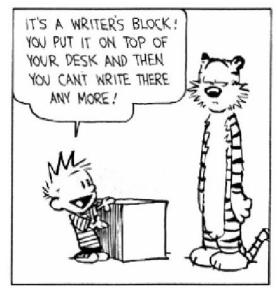
* Open
- Roots
- hema, hemo--blood
- here, hes--stick
* Conclusion
Here are some notes from the University of North Carolina, Chapel Hill:
Conclusions are hard to write, but they can be a gift to your reader:
Introductions and conclusions can be the most difficult parts of papers to write. While the body is often easier to write, it needs a frame around it. An introduction and conclusion frame your thoughts and bridge your ideas for the reader.
Just as your introduction acts as a bridge that transports your readers from their own lives into the “place” of your analysis, your conclusion can provide a bridge to help your readers make the transition back to their daily lives. Such a conclusion will help them see why all your analysis and information should matter to them after they put the paper down.
Your conclusion is your chance to have the last word on the subject. The conclusion allows you to have the final say on the issues you have raised in your paper, to summarize your thoughts, to demonstrate the importance of your ideas, and to propel your reader to a new view of the subject. It is also your opportunity to make a good final impression and to end on a positive note.
Your conclusion can go beyond the confines of the assignment. The conclusion pushes beyond the boundaries of the prompt and allows you to consider broader issues, make new connections, and elaborate on the significance of your findings.
Your conclusion should make your readers glad they read your paper. Your conclusion gives your reader something to take away that will help them see things differently or appreciate your topic in personally relevant ways. It can suggest broader implications that will not only interest your reader, but also enrich your reader’s life in some way. It is your gift to the reader.
Things to consider doing:
-
Play the “So What” Game. If you’re stuck and feel like your
conclusion isn’t saying anything new or interesting, ask a friend to
read it with you. Whenever you make a statement from your conclusion,
ask the friend to say, “So what?” or “Why should anybody care?” Then
ponder that question and answer it. Here’s how it might go:
- You: Basically, I’m just saying that education was important to Douglass.
Friend: So what?
You: Well, it was important because it was a key to him feeling like a free and equal citizen.
Friend: Why should anybody care?
You: That’s important because plantation owners tried to keep slaves from being educated so that they could maintain control. When Douglass obtained an education, he undermined that control personally.
-
Return to the theme or themes in the introduction. This strategy
brings the reader full circle. For example, if you begin by describing a
scenario, you can end with the same scenario as proof that your essay
is helpful in creating a new understanding. You may also refer to the
introductory paragraph by using key words or parallel concepts and
images that you also used in the introduction.
-
Synthesize, don’t summarize: Include a brief summary of the paper’s
main points, but don’t simply repeat things that were in your paper.
Instead, show your reader how the points you made and the support and
examples you used fit together. Pull it all together.
Things to avoid doing:
-
Beginning with an unnecessary, overused phrase such as “in
conclusion,” “in summary,” or “in closing.” Although these phrases can
work in speeches, they come across as wooden and trite in writing.
-
Stating the thesis for the very first time in the conclusion.
-
Introducing a new idea or subtopic in your conclusion.
-
Ending with a rephrased thesis statement without any substantive changes.
-
Making sentimental, emotional appeals that are out of character with the rest of an analytical paper.
-
Including evidence (quotations, statistics, etc.) that should be in the body of the paper.
HW: Complete RD due tomorrow; FD due Wednesday
No comments:
Post a Comment